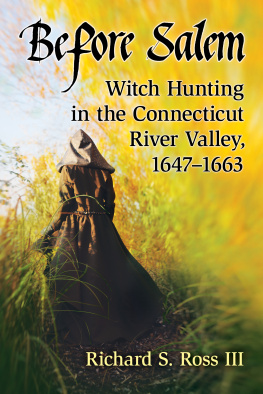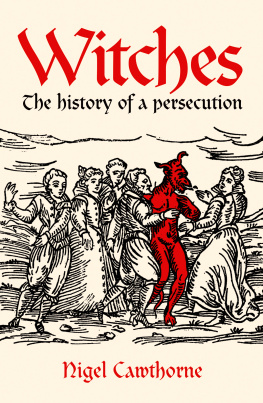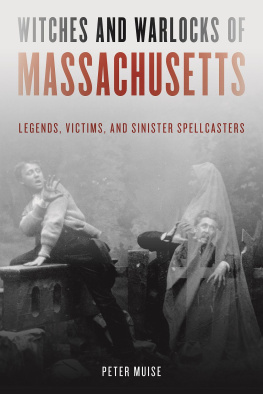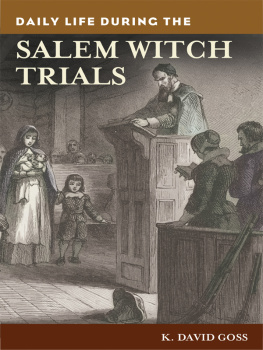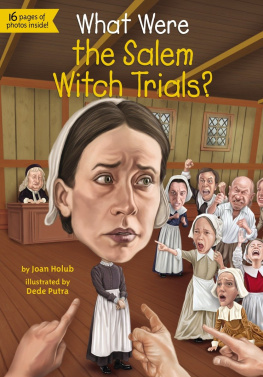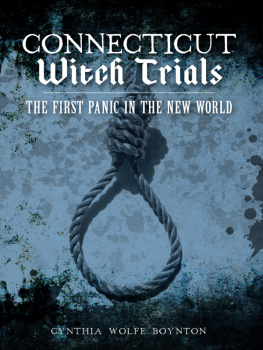
Before Salem
Witch Hunting in the Connecticut River Valley, 16471663
RICHARD S. ROSS III

McFarland & Company, Inc., Publishers
Jefferson, North Carolina
LIBRARY OF CONGRESS CATALOGUING DATA ARE AVAILABLE
BRITISH LIBRARY CATALOGUING DATA ARE AVAILABLE
e-ISBN: 978-1-4766-2779-3
2017 Richard S. Ross III. All rights reserved
No part of this book may be reproduced or transmitted in any form or by any means, electronic or mechanical, including photocopying or recording, or by any information storage and retrieval system, without permission in writing from the publisher.
Front cover image 2017 iStock
McFarland & Company, Inc., Publishers
Box 611, Jefferson, North Carolina 28640
www.mcfarlandpub.com
Acknowledgments
I would thank the following institutions for their contributions to this work.
Hay Library, Brown University, Providence, Rhode Island
Connecticut State Library, Hartford, Connecticut
Historic Winslow House Association, Marshfield, Massachusetts
Wellcome Library, London
The Library, Westminster Abbey, London
Trinity College Library, Hartford, Connecticut
Watkinson Library, Special Collections Division of the Trinity College Library
I want to also thank the librarians I have known over the years, especially the interlibrary loan librarians at the various academic institutions who assisted me in acquiring the numerous books and articles for my research. They are truly the unsung heroes of academia. For this book I am especially indebted to the interlibrary loan staff of the Trinity College Library and the staff in the Special Collections Division of the Watkinson Library.
I would like to acknowledge my parents Richard S. Ross, Jr., and Mary Plevell Ross, who without them this work would never have existed. I would also like to acknowledge my two children, Richard and Nicole, and my two grandchildren, Mitzie and Billy, who brought joy and laughter to the house in the midst of this serious subject. Finally, I want to thank my wife, Christine, whose editorial assistance, patience and advice allowed this book to finally come to completion.
Preface
This book grew out of my long-time interest in witchcraft primarily in continental Europe and England. In 2005 I began to teach a class on witchcraft at Trinity College in Hartford, Connecticut. I decided to focus the course on the English origins of witchcraft in Colonial America with emphasis on the Salem trials to provide ready resources for my students. In teaching and researching for the course over a number of years the course evolved as I came to the realization Connecticut had its own significant share of witchcraft trials and executions prior to the Salem trials. Although not as resource rich as the Salem trials there was sufficient material for students to successfully investigate these earlier trials.
Salem has for a long time cast a shadow over the Connecticut witch trials. Its effect can be summed up in the words of the late nineteenth century author of The Devil in Britain and America (1896), who wrote: The following are the known cases of witchcraft in Connecticut but as far as I can see, none present any particular feature of interest to the reader.
Even today most people in Connecticut let alone New England are unfamiliar with the fact there were witch trials in the mid-seventeenth century Connecticut River Valley in which eleven individuals were executed, including the first witch hanged in New England in 1647 in Hartford, Connecticut.
As for my own research I began to see the unique situations in the Connecticut River Valley. There were obvious connections between the witch lore, the English demonologists, the legal system, and the trials in England and New England.
The book I have written takes a different perspective on witchcraft in early colonial New England. I place the origins of the witchcraft trials in what has also been called the New England wilderness from 1647 to 1662/63 not only in the unique conditions in the Connecticut River Valley but within the wider context of migrants who, while on the New England frontier, managed to maintain active communications with their homeland.
The connection to England was continuous during the period under this study. As the book shows the political, religious and social ferment in England during this period in conjunction with life on the New England frontier deeply affected the colonists, especially the ongoing and later outcome of the English Civil War.
The collapse of the central government, the ensuing power vacuum in England, and the witchcraft accusations between the Royalists and Roundheads led to a renewal of witchcraft accusations and trials in England, especially under the leadership of Matthew Hopkins in East Anglia. It was during this period when the New England colonies were left on their own that witchcraft statutes became part of the colonial legal systems. As the witchcraft accusations and executions in England increased the hysteria spread to New England. New tools and techniques for examining witches were quickly adopted by the authorities in New England.
Contributing to the general unease and suspicions in the New England wilderness were the Native Americans, who the colonists feared might attack them physically while clergy preached they were agents of the devil prepared to attack them spiritually with his aid. Additionally, they faced a harsh environment, famine, recurring epidemics, and an unforgiving religion which offered no relief from perceived maleficia by suspected witches, the devil and his demons. Later additional unease and fear was generated by rebellion, the continued threat of Indian attack, the legitimacy of land ownership without a Royal charter and for clergy the exclusiveness of congregationalism in New England and the governance of their churches as a result of the restoration of Charles II in England.
Unfortunately there are few records available for witch trials in the Connecticut River Valley. For later trials there are some depositions and other documents found in the Samuel Wyllys papers along with English legal manuals, printed reports from the colonies of Connecticut and New Haven, documents printed by the Massachusetts and Connecticut historical societies and other primary source publications available that allow us to piece together the history of witch hunting in the Connecticut River Valley.
The first witchcraft trials from 1647 to 1662/63 influenced both Increase Mather and Cotton Mather in their books on witchcraft in Colonial America and provide continuity and a connection to the later Salem witch trials. We find in these earlier reports demonic possession, bewitchment, counter-magic, the type of accusations that rose to the level of witchcraft, legal issues confronting judges and juries, the clergys role in suspected witch examinations, trials, and following conviction, the pact or covenant with the devil and the outcome and consequences of various trials. These reports undoubtedly provided some measure of guidance for good or for ill to the authorities and clergy in the years leading up to and including the Salem trials.
This book provides new material on witchcraft in the Connecticut River Valley. I have been able to provide connections among individuals in Colonial America and England that show how and why individuals participated in specific events outlined in this book. A few other examples of new material I provide includes the origins and reasons for the execution of the first witch in New England; new information on the demonic possession of a young woman during the Hartford witch hunt, including her familys unique connection with the troubled Hartford Church; and a prior witchcraft trial in New Haven. Other material concerns background on the family of a young girl bewitched to death, initiating the Hartford witch hunt. Additionally, I explain the origin of the undated document
Next page
